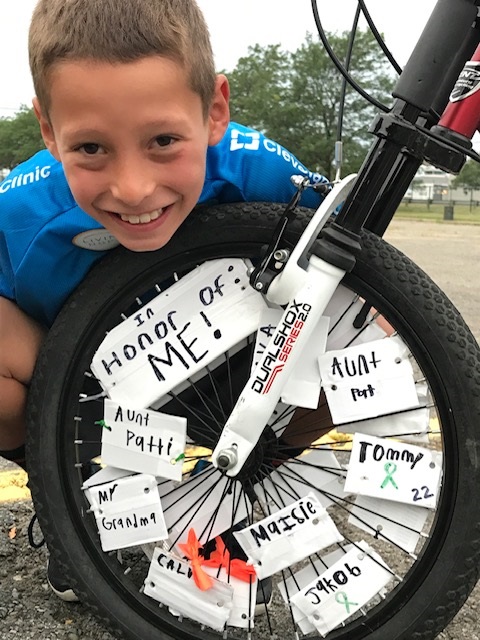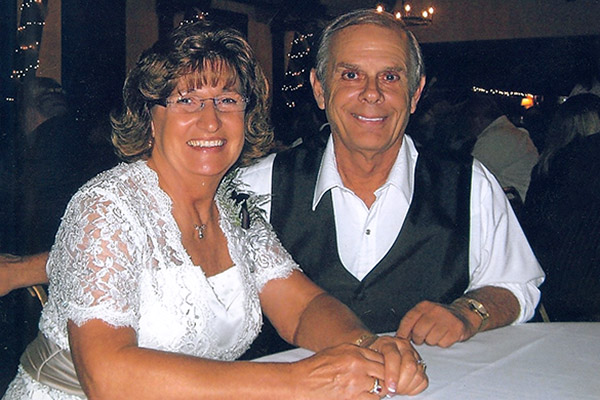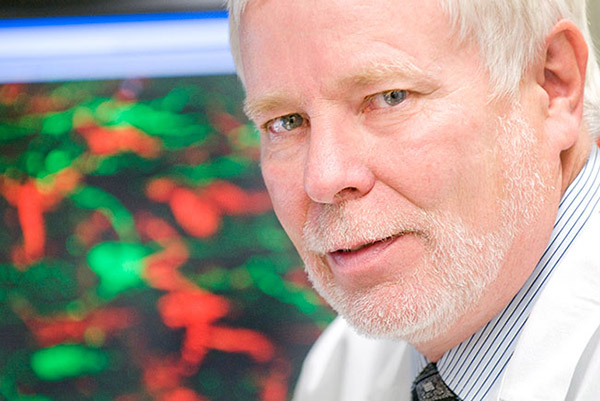12-Year-Old Cancer Survivor Hopes to Raise $10K for VeloSano

“Never in a million years did I think we’d be doing this, because never in a million years did I think that would happen,” says Wren Timura.
She’s talking about riding in VeloSano, the “Bike to cure” event taking place in Cleveland July 19-21, with her son Owen, who was diagnosed with a rare pediatric cancer when he was just 8 years old.
The Beginning
When Owen first told Wren and his dad, Matt, he’d noticed a lump on his abdomen, they thought it might be a sports injury. It didn’t hurt, so they waited a week before visiting the pediatrician, who told them it was an infected hair follicle and prescribed an antibiotic. But the medicine didn’t work – in fact, the lump seemed to get larger. They visited another doctor, who concurred about the diagnosis and prescribed a stronger antibiotic.
Still the lump grew bigger.
Because it wasn’t responding to the antibiotics, their doctor recommended going to Cleveland Clinic Children’s for a simple surgery to drain the fluid. “They said it would take about 45 minutes,” recalls Wren.
An hour and half after the procedure began, Owen’s surgeon introduced Wren and Matt to Ilia Buhtoiarov, MD, a pediatric oncologist. “They told us that as soon as they’d opened it up they could tell that the mass was cancerous,” says Wren. “They needed to wait for the pathology report but they were pretty confident that it was a type of lymphoma.”
Four days later, the pathology report confirmed that Owen had non-Hodgkin’s anaplastic large cell lymphoma – a rare form of cancer found in 1% of children.
How Do You Tell an 8-year-old That He Has Cancer?
“I didn’t want to use the word ‘cancer’ with him because the only thing he knew about it was that my dad had died of a brain tumor when I was 14,” says Wren. “He’s kind of a sensitive kid, and I didn’t want him to make that the connection.”
But after meeting with Cleveland Clinic Children’s Child Life Specialists, Wren and Matt realized there was no way to avoid it. “You can’t predict what other people will say around him,” Wren says. “They told us that we had to be honest, and that he’s going to have to grow up pretty fast. He’s going to go from an 8-year-old kid to about a 15-year-old – not physically, but mentally. So, we did it. We told him that he’d lose his hair, he wouldn’t be able to go to school for a while, he wouldn’t be able to play sports, but we were going to fight this with him.”
For the next six months, the Timuras juggled their family life with Owen’s hospitalizations. He was an inpatient for one week receiving treatment and then was home for two weeks to recover. Thankfully, he responded well to the chemotherapy and now has been cancer-free for three years.
VeloSano: Their Special Cause
By 2016, Owen was in remission but was on blood thinners and still feeling the effects of chemo. His nurses were riding in VeloSano and asked if they could put his photograph at a rest stop to inspire them as they rode. That year, Owen and his mom went to Cleveland to cheer on his care team by ringing cowbells with the rest of the crowd as his nurses pedaled by. “I looked at him and said next year we’re doing this,” Wren says.
In 2017, Owen and his mom signed up to ride and raise funds for cancer research at Cleveland Clinic. “I know that everyone has their own special ‘cause’,” Wren says. “Until something becomes so personal to you, you don’t realize the difference that $20 or $50 can make.”
Each year they’ve easily doubled their fundraising commitment, becoming Big Wheelers. This year, in VeloSano 6, they hope to reach a cumulative fundraising total of $10,000.
Wren and Owen, now 12, ride with his doctors and nurses. “It’s extremely meaningful to have their patients ride with them,” Wren says. “For them to see why they’re doing their job – he’s right there.”
One hundred percent of funds raised through VeloSano goes toward cancer research at Cleveland Clinic. In its first five years, VeloSano has generated over $17 million, which has been used to fund 115 cancer research projects. Because Owen is riding as a member of Team Cleveland Clinic Children's, 100% of the funds he raises will support pediatric cancer research.
“People should give money to VeloSano so they can help kids that have cancer and try to get it cured so nobody else has to deal with it because it’s not a fun process at all,” says Owen. “Nobody really wants to deal with it so you can help the people who study so nobody ever has to have it.”
How You Can Help
Ride. Volunteer. Fundraise. Donate. There are many ways to get involved in VeloSano. No matter how you do it, 100% supports lifesaving cancer research at Cleveland Clinic.
Double the Support: Patient’s Gifts Help Researcher in Two Ways

Seated at a table next to his wife, Arlene, 74-year-old Dave Archer has a twinkle in his eye as he begins to tell his remarkable story. He readily admits to trying to find humor in everything – even a disabling disease: idiopathic pulmonary fibrosis (IPF), which has no known cure and few treatment options.
He was diagnosed with IPF in 2013 by Lloyd Dennis, MD, his physician in Barlow, Ohio, who encouraged him to make the two-and-a-half-hour drive to Cleveland Clinic for treatment. That’s where he and Arlene met Brian Southern, MD, a physician-scientist in Cleveland Clinic’s Respiratory Institute and Lerner Research Institute's Department of Inflammation and Immunity.
In IPF, lung tissue becomes scarred and changes the lung's ability to function normally. The scarring usually begins at the edges of the lungs and advances toward the center of the lungs. Typically, mild scarring occurs first, but over time, the normal lung tissue is replaced by more heavily scarred lung tissue, making it difficult to breathe and deliver needed oxygen to the body. There is no cure for IPF. The damage caused by the lung scarring cannot be reversed. In addition, the progression of the disease cannot be predicted or stopped. Lung transplant surgery may be considered for patients who have advanced disease.
His Only Option
By 2015, Dave’s symptoms had worsened and Dr. Southern prescribed one of the drugs approved to treat IPF. But the side effects were too much and he had to stop taking it. Dave then took the other drug approved to treat IPF, and while it slowed the progression of the disease, his lung function was still declining. A life-saving lung transplant became his only option.
At this point, Dave wasn’t able to work anymore and could barely get out of his chair even though he was on 15 liters of oxygen. “I didn’t think I was going to make it. They said if a lung wasn’t soon available, they’d put me on a ventilator. So it was getting pretty bad.”
Dave and Arlene have been married for 52 years. They finish each other’s sentences, and he still makes her laugh with corny jokes. “As a caregiver, it takes a lot,” Arlene says about caring for someone with IPF. “You go through the ups and downs just like they do. And you’ve got to keep building them up. And some days you get discouraged too and think, oh no, is our lifestyle going to remain this way forever?”
Finally, in March 2016, Dave got the call that a set of lungs was available.
Following the double-lung transplant surgery, “I looked like a skinned raccoon laying there for a while – I was down to 150 pounds,” Dave says in his typical self-deprecating fashion.
The couple recently celebrated the three-year anniversary of Dave’s transplant. He takes 46 pills every day: anti-rejection, vitamins, prednisone, anti-viral infection and blood-sugar medicine. He fist-bumps enthusiastically instead of shaking hands because of his weakened immune system and is still rebuilding his strength after not being able to exercise for almost two years.
At first, Dave and Arlene were worried that he would “just be a number” at Cleveland Clinic because it’s so big. “I thought up here, you know, I’ll just roll on down the assembly line, but they didn’t do that. They treated us with compassion,” Dave says. “It wasn’t like, oh, here’s another double lung transplant. The whole transplant group is just amazing. We never ran into anybody who wouldn’t take the time to see how we were doing.”
The couple now volunteers to meet with potential transplant candidates before and after surgery to share their experiences as patient and caregiver. “I realized that while the doctors could talk about the operation, they’d never had a transplant, but I had,” Dave says. “I can offer a different perspective than they can.”
“A Huge Gift”
Dave and Arlene wanted to help advance IPF research, so they eagerly gave permission for Dr. Southern to use his diseased lungs for experiments. “He said mine were pretty bad and he was glad to get them,” Dave says. “He said they might be able to find out if any of the clinical trial meds had any effect on them.”
Dr. Southern says most patients do not donate their “old” lungs for use in research. “Just the gift of one lung – the amount and variation of things you’re able to do with it – is incredible,” he says. “To receive that is a huge gift for us.”
Dr. Southern is working on a particular protein called myosin, to see how lung tissue interacts with the protein in fibroblasts, and how it may cause the disease to progress. Others in his lab are looking at a protein called thrombin and how it may be involved. “We preserve some of the tissue to look at protein levels, DNA and RNA, to compare with lung tissue that doesn’t have IPF, so we can see the different behavior of the cells,” he says.
In addition, a genetic component recently was identified, leading to a whole new understanding of the cause and progression of the disease. “This led to two drugs that currently are available and to the pipeline of new drugs that are now in clinical trials,” he says. “Early studies suggest that they may be able to halt or even reverse some of the damage.”
Scientific Research is Expensive
Dave and Arlene, who own one of the largest pipe and steel fabricators in the Midwest, then decided to give even more: They made a generous donation to support Dr. Southern’s research. “We’re pretty lucky, and my mom and dad always said you have to give back,” Dave says. “We both think that putting money and effort into Dr. Southern’s work can’t do anything but make things better for the next ones who’ll have IPF.”
Dr. Southern is very grateful for the Archers’ generosity. “When someone gives a philanthropic gift for research, that money goes directly to doing the experiments,” he says. ”That takes a huge burden off the researcher, who would have been spending that time sitting in the office, writing, writing, writing – trying to convince someone to provide the money to do this research. The gifts I’ve received have allowed me to actually get in the lab and do the experiments that I need to do.
“People wonder why science seems so slow and that’s why: a big amount of time is spent trying to acquire funding to keep the research going and not actually doing the work,” Dr. Southern continues. “Scientific research is expensive. The Archers’ gift has really freed me up: I can get in the lab and do the experiments and we’ve been able to hire a really good technician. The data’s really starting to pour out now, and that’s what’s needed to make scientific progress.”
How You Can Help
As a nonprofit healthcare provider, Cleveland Clinic counts on your support to help fund critical medical studies like Dr. Southern’s research.
Doctors Supporting Doctors: Philanthropy Funds MS Discoveries

Multiple sclerosis has long been characterized as a disease of the brain’s white matter, where immune cells destroy myelin – the fatty protective covering on nerve cells. The destruction of myelin (called demyelination) was believed to be responsible for nerve cell (neuron) death that leads to irreversible disability in patients with MS.
However, a research team led by Bruce Trapp, PhD, identified for the first time a subtype of the disease that features neuronal loss but no demyelination of the brain’s white matter. The findings, published in 2018 in Lancet Neurology, could lead to more personalized diagnosis and treatments.
Dr. Trapp is Chair of the Department of Neurosciences at the Lerner Research Institute and Professor of Molecular Medicine at Cleveland Clinic’s Lerner College of Medicine. He holds the Morris R. and Ruth V. Graham Endowed Chair in Biomedical Research, funding from which enables the kind of collaborative efforts that make discoveries like this possible.
What’s more, Dr. Trapp says, his benefactor is an esteemed colleague and friend. “It makes the gift that much more meaningful to me,” he says.
The chair was established by Linda Graham, MD, a vascular surgeon and researcher at Cleveland Clinic. Dr. Graham named the chair in honor of her parents.
“Neurodegenerative diseases hold personal significance to me,” Dr. Graham says. “I am delighted that Dr. Trapp was selected to hold the Morris R. and Ruth V. Graham Chair in Biomedical Research. He is a friend and an outstanding researcher who is making a significant impact in neurodegenerative diseases. I could not ask for a better use of the gift.”
“It is an honor to be the Morris R. and Ruth V. Graham Endowed Chair in Biomedical Research,” Dr. Trapp says. “It will provide funding to build upon my program and accelerate new discoveries.”
Dr. Trapp notes that his recent study opened up a new arena in MS research. “It is the first to provide pathological evidence that neuronal degeneration can occur without white matter myelin loss in the brains of patients with the disease.”
The research is essential to improving patient care, says Daniel Ontaneda, MD, a neurologist at Cleveland Clinic’s Mellen Center for Multiple Sclerosis within the Neurological Institute. “The identification of this new MS subtype highlights the need to develop more sensitive strategies for properly diagnosing and understanding the pathology of MS. We are hopeful these findings will lead to new tailored treatment strategies for patients living with different forms of MS.”
How You Can Help
Scientific discoveries can lead to better outcomes and, ultimately, cures.
29th Annual Cleveland Clinic Children’s Gala Raises Nearly $1.4 Million
More than 650 guests at the 29th Annual Cleveland Clinic Children’s Gala celebrated the bravery of our littlest patients and gave generously to support our innovative pediatric research. Held on Saturday, May 4, at the Hilton Cleveland Downtown, the event raised nearly $1.4 million.
This year’s Courage Award honored the accomplishments of 11-year-old Vinny Mercurio, who continues to amaze his care team, family and friends as he works to overcome the effects of a stroke. Sixteen-year old Daisey Yu, a former patient, dazzled the crowd with a powerful performance on the piano. And guests enjoyed a video of three charming young patients who took charge as they interviewed pediatric doctors about why philanthropic funding is so important to their research.
Led by Honorary Co-Chairs Lorraine Dodero and Umberto Fedeli and presented by the Cleveland Cavaliers and the Scala Family Foundation, Cleveland Clinic Children’s annual gala is focused on honoring brave children facing medical obstacles and the dedicated caregivers who work tirelessly to help them heal. Funds raised at the event will help advance groundbreaking research and lifesaving treatments for children’s diseases and disorders.
How You Can Help
It’s never too late to support Cleveland Clinic Children’s. As a nonprofit healthcare institution, we count on your gifts to further our lifesaving pediatric research.

